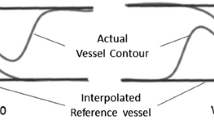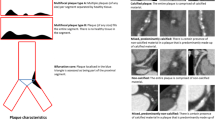Abstract
The ABC classification of the American College of Cardiology and the American Heart Association is a commonly used categorization to estimate the risk and success of intracoronary intervention, as well as the probability of restenosis. To evaluate the reliability of qualitative angiogram readings, we randomly selected 200 films from single lesion angioplasty procedures. A repeated visual assessment (≥ 2 months interval) by two independent observers resulted in kappa values of inter and intra-observer variability for the ABC lesion classification and for all separate items that compile it. Variability in assessment is expressed in percentage of total agreement, and in kappa value, which is a parameter of the agreement between two or more observations in excess of the chance agreement. Percentage of total agreement and kappa value was 67.8% and 0.33 respectively for the ABC classification, indicating a poor agreement. Probably this is due to the deficiency of strict definitions. Further investigation has to demonstrate whether improvement can be achieved using complete and detailed definitions without ambiguity, and consensus after panel assessment.
Similar content being viewed by others
References
Ryan TJ, Faxon DP, Gunnar RM, Kennedy JW, King SB III, Loop FD, Peterson KL, Reeves TJ, Williams DO, Winters WL Jr. Guidelines for percutaneous transluminal coronary angioplasty: a report of the American College of Cardiology/American Heart Association Task Force on assessment of diagnostic and therapeutic cardiovascular procedures (subcommittee on percutaneous transluminal coronary angioplasty). J Am Coll Cardiol 1988; 12: 529–45 and Circulation 1988; 78: 486–502
Ryan TJ, Bauman WB, Kennedy JW, Kereiakes DJ, King SB, McCallister BD, Smith SC jr, Ullyot DJ. Guidelines for percutaneous transluminal coronary angioplasty: A report of the American College of Cardiology/American Heart Association Task Force on assessment of diagnostic and therapeutic cardiovascular procedures (committee on percutaneous transluminal coronary angioplasty). J Am Coll Cardiol 1993; 22(7): 2033–54 and Circulation 1993; 88(6): 2987–3007.
Ellis SG, Vandormael MG, Cowley MJ, DiSciascio G, Deligonul U, Topol EJ, Bulle TM and the multivessel angioplasty prognosis study group. Coronary morphologic and clinical determinants of procedural outcome with angioplasty for multivessel coronary disease. Circ 1990; 82: 1193–1202
Bertrand ME, Lablanche JM, Bauters C, Leroy F, Mac Fadden E. Discordant results of visual and quantitative estimates of stenosis severity before and after coronary angioplasty. Cath and Cardiovasc Diagn 1993; 28: 1–6
The TIMI study group. The Thrombolysis In Myocardial Infarction (TIMI) trial: phase I findings. N Engl J Med 1985; 312: 932–936
Braunwald E. Unstable angina pectoris. A classification. Circulation 1989; 80: 410
Ambrose JA, Winters SL, Arora RR, Haft JI, Goldstein J, Rentrop KP, Gorlin R, Fuster V. Coronary angiographic morphology in myocardial infarction: a link between the pathogenesis of unstable angina and myocardial infarction. Journ American Coll Cardiol 1985; 6(6): 1233–1238
Fleiss JH. Statistical methods for rates and proportions. 2nd ed. John Wiley & Sons Inc. 1981: 212–236
Beauman GJ, Vogel RA. Accuracy of individual and panel visual interpretations of coronary arteriograms: implications for clinical decision making. Journ Am Coll Cardiol 1990; 16(1): 108–113
Ellis S, Alderman EL, Cain K, Wright A, Bourassa M, Fisher L, and the participants of the coronary artery surgery study (CASS). Morphology of left anterior descending coronary territory lesions as a predictor of anterior myocardial infarction: a CASS registry study. Journ Am Coll Cardiol 1989; 13(7): 1481–91
Hermans WRM, Foley DP, Rensing BJ, Rutsch W, Heyndrickx GR, Danchin N, Mast G, Hanet C, Lablanche JM, Rafflenbeul W, Uebis R, Balcon R, de Feyter PJ, Serruys PW, on behalf of the Carport and Mercator Study Groups. Usefulness of quantitative and qualitative angiographic lesion morphology, and clinical characteristics in predicting major adverse cardiac events during and after native coronary balloon angioplasty. Am J Cardiol 1993; 72: 14–20
Rose AD, Detre KM, Alderman ELL, Stadius M, Sopko G, and the Bypass Angioplasty Revascularization Investigation Study Group. How reliable is the assessment of coronary angiography? (abstract no 3515) Circ (Suppl) 1993; 88 (4 part 2): I-653
Myler RK, Shaw RE, Stertzer SH, Hecht HS, Ryan C, Rosenblum J, Cumberland DC, Murphy MC, Hansell HN, Hidalgo B. Lesion morphology and coronary angioplasty: current experience and analysis. JACC 1992; 19: 1641–52
Mabin AT, Holmes DR, Smith HC, Vlietstra RE, Bove AA, Reeder GS, Chesebro JH, Bresnahan JF, Orszulak TA. Intracoronary thrombus: role in coronary occlusion complicating percutaneous transluminal coronary angioplasty. JACC 1985; 5: 198–202
Author information
Authors and Affiliations
Rights and permissions
About this article
Cite this article
Herrman, JP.R., Azar, A., Umans, V.A.W.M. et al. Inter- and intra-observer variability in the qualitative categorization of coronary angiograms. Int J Cardiac Imag 12, 21–30 (1996). https://doi.org/10.1007/BF01798114
Accepted:
Issue Date:
DOI: https://doi.org/10.1007/BF01798114




